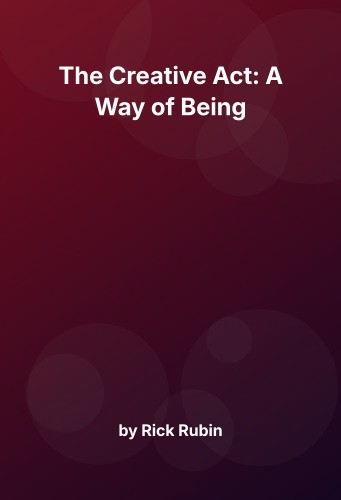The Creative Act: A Way of Being - A Strategic Exploration
Rick Rubin’s “The Creative Act: A Way of Being” is a profound exploration of creativity as a dynamic process that transcends traditional boundaries. Rubin, a legendary figure in the music industry, offers insights that extend beyond artistic endeavors, presenting a blueprint for innovation and transformation in the professional realm. This summary distills the essence of Rubin’s work into strategic insights that professionals can harness to foster creativity and drive change within their organizations.
Embracing the Creative Mindset
At the heart of Rubin’s philosophy is the idea that creativity is not a finite resource but a way of being. This mindset shift is crucial for professionals seeking to cultivate innovation. Rubin argues that creativity is accessible to everyone and can be nurtured through openness, curiosity, and a willingness to embrace uncertainty. This perspective aligns with the principles of agile methodologies, which emphasize iterative development and adaptability. By adopting a creative mindset, professionals can navigate complex challenges and seize opportunities for growth.
Comparatively, in “The War of Art” by Steven Pressfield, the focus is on overcoming resistance to creative work. Pressfield highlights the internal battles that hinder creative expression, whereas Rubin emphasizes an innate potential that can be unlocked through mindset shifts. Similarly, “Big Magic” by Elizabeth Gilbert explores the enchantment of creativity, advocating for a fearless pursuit of creative endeavors. Rubin’s approach complements these works by offering a practical framework to harness creativity in everyday professional scenarios.
The Power of Intuition and Presence
Rubin emphasizes the importance of intuition and presence in the creative process. He suggests that intuition is a powerful tool for decision-making, enabling individuals to tap into their subconscious knowledge and insights. In a business context, this translates to trusting one’s instincts and being attuned to subtle cues in the environment. Presence, or the ability to be fully engaged in the moment, enhances focus and clarity, leading to more effective problem-solving and innovation.
In practical terms, this can be likened to the concept of “flow” described by Mihaly Csikszentmihalyi in his book “Flow: The Psychology of Optimal Experience.” Csikszentmihalyi explains how being in a state of flow leads to peak creativity and productivity. Rubin’s focus on intuition parallels this by suggesting that professionals cultivate an environment where such flow states can naturally occur.
Cultivating a Culture of Creativity
Creating an environment that fosters creativity is essential for organizational success. Rubin highlights the role of leadership in setting the tone for a creative culture. Leaders must encourage experimentation, value diverse perspectives, and provide the psychological safety necessary for individuals to take risks. This approach is reminiscent of Google’s “20% time” policy, which allows employees to dedicate a portion of their workweek to passion projects. Such initiatives can lead to breakthrough innovations and increased employee engagement.
The Intersection of Art and Business
Rubin draws parallels between artistic expression and business strategy, illustrating how principles from the arts can inform corporate practices. He advocates for a holistic approach to problem-solving that integrates analytical and creative thinking. This interdisciplinary perspective is crucial in today’s digital landscape, where businesses must navigate complex ecosystems and rapidly evolving technologies. By leveraging the creative act, organizations can develop innovative solutions that drive competitive advantage.
Frameworks for Innovation
Rubin introduces several frameworks that professionals can apply to enhance creativity and innovation. One such framework is the concept of “beginner’s mind,” which encourages individuals to approach challenges with fresh eyes and an open mind. This mindset can lead to novel insights and solutions, as it allows for the questioning of assumptions and exploration of new possibilities. Another framework is the “artist’s journey,” which parallels the hero’s journey in storytelling. This model emphasizes the transformative power of creativity and the importance of perseverance in the face of adversity.
Navigating the Digital Transformation
In the context of digital transformation, Rubin’s insights are particularly relevant. As organizations embrace new technologies, they must also adapt their strategies and processes to remain competitive. Rubin’s emphasis on adaptability and continuous learning aligns with the principles of digital agility, which prioritize flexibility and responsiveness. By fostering a culture of creativity and innovation, businesses can successfully navigate the challenges of the digital age and capitalize on emerging opportunities.
Final Reflection: Creativity as a Catalyst for Change
Rick Rubin’s “The Creative Act: A Way of Being” offers a compelling vision of creativity as a catalyst for personal and organizational transformation. By embracing a creative mindset, cultivating a supportive culture, and leveraging strategic frameworks, professionals can unlock new levels of innovation and drive meaningful change. Rubin’s insights provide a valuable roadmap for navigating the complexities of the modern business landscape and achieving sustainable success.
In synthesizing the cross-domain relevance of Rubin’s work, we find parallels in leadership and design thinking. Leaders who foster environments where creativity thrives are more likely to inspire innovation and resilience. Similarly, the principles of design thinking, as discussed in “Change by Design” by Tim Brown, echo Rubin’s advocacy for iterative learning and user-centered problem solving. Both approaches emphasize empathy, experimentation, and the reframing of challenges to unlock creative potential.
As organizations continue to face rapid changes and disruptions, adopting Rubin’s principles can serve as a guiding beacon for leaders and teams aiming to cultivate a culture where creativity is not just encouraged but is an integral part of the organizational DNA. In this way, creativity becomes a strategic asset, capable of driving sustained competitive advantage and meaningful impact across industries.

